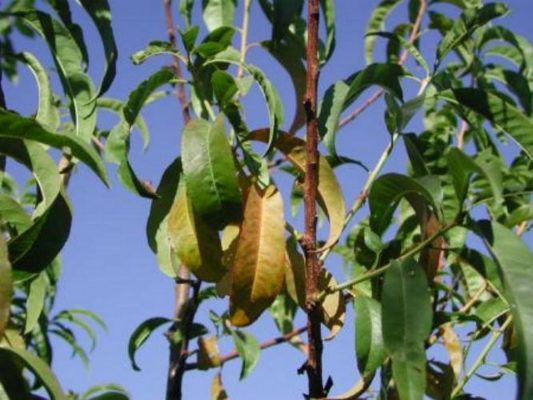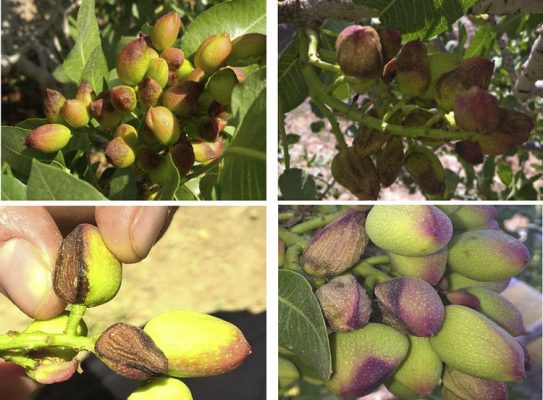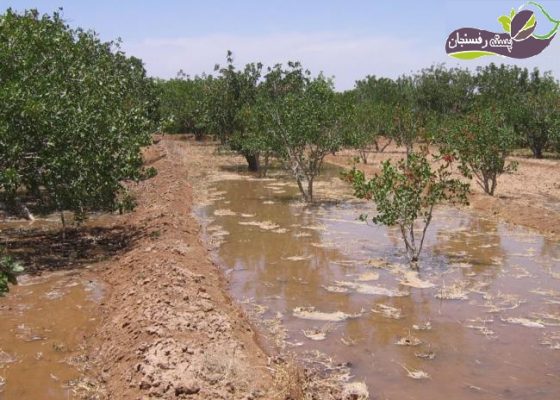pistachio is one of the most popular fruits in nuts, which requires a lot of steps to achieve a good taste and a good pistachio. Half of the story ends with the care and maintenance of pistachio trees. pistachio trees need attention and care in order to give a good load to the farmer. |
Proper nutrition of pistachio trees
pistachio is one of the most popular fruits in nuts, which requires a lot of steps to achieve a good taste and a good pistachio. Half of the story ends with the care and maintenance of pistachio trees. pistachio trees need attention and care in order to give a good load to the farmer. Because all of these reviews show up in your final product. Identifying the status of nutrients in the soil, leaves and fertilizing pistachio trees based on soil and leaf decomposition, for each nutrient based on the standard and critical limits of the existence of the following executive solutions is recommended.
Feeding pistachio trees – nitrogen deficiency
It is usually difficult to detect nitrogen deficiency in the soil and it depends a lot on determining the root density of pistachio trees and soil sampling. The critical nitrogen content in the soil is 0.1-0.2%. It is easier to determine the exact amount of deficiency by leaf analysis. So that the critical limit of nitrogen in pistachio leaves is 2.2-2% of dry matter. Symptoms of nitrogen deficiency early in the growing season are such that the lower leaves of the tree are fainter, smaller, with reduced leaf area and reduced growth of tree branches and crowns, and in autumn the old leaves are earlier and fall off earlier than usual. Nitrogen deficiency at the beginning of the season causes yellowing of the leaves on the branches, reduced growth, small leaves and narrowed branches of the newly grown branches, and at the end of the season it causes low cerebellum and light grains.

Figure1-pistachio trees
Eliminate nitrogen deficiency in pistachio trees
In order to eliminate nitrogen deficiency in pistachio orchards, due to soil and leaf decomposition and critical limits of this element in pistachio soil and leaf, next year’s yield and yield, texture, salinity and soil organic matter, both organic and chemical fertilizers should be used. . Animal and poultry manure contains some nitrogen and their use can meet some of the nitrogen needs of trees, and due to the great need of pistachio trees for nitrogen, especially in the productive year, the use of chemical nitrogen fertilizers is appropriate, necessary and necessary. Nitrogen fertilizers are effective when they are given to the tree in small amounts but more often when the plant is growing, especially in light soils with nitrogen washing tissue in the form of high nitrate in them. Fruit trees that shed their leaves in winter absorb more nitrogen from the soil during the growing season than during dormancy. The time of full utilization of soil nitrogen in pistachio trees is often from May to late August, which is true in both high-yield and low-yield years. Because the amount of nitrogen in the organs of the trees during the winter is stored until the next year, it will be used again for the growth and fruiting of the trees; Therefore, its absorption rate from soil is slow at the beginning of spring and also during winter hibernation, not much nitrogen is absorbed by pistachio trees, so adding nitrogen fertilizers to the soil after harvest, this is main October and November, was not very desirable and it seems so. It will be very useful and effective to add a limited amount of nitrogen to the soil in early spring. This is main from April to the end of May, based on the irrigation cycle of the garden. In general, the approximate requirement of pistachio trees is 600 grams of nitrogen per tree, which if 300 organic fertilizers are used per tree, it seems that based on the percentage of nitrogen in nitrogen fertilizers, the consumption of each fertilizer can be calculated. When using nitrogen fertilizers in gardens, care should be taken that these fertilizers do not accumulate in any type so that the plant and its roots are away from possible damage.

Figure2-pistachio trees
pistachio trees nutrition – phosphorus deficiency
The critical level of phosphorus in the soil is 15 mg / kg or PPM and in the leaves of pistachio trees is 0.1-0.14% of the dry matter. If the plant is deficient, the leaves on the branches turn purple and the leaves gradually fall off, the stems become narrower, and the distance between the nodes increases. Naked trees and limited root growth are other symptoms of deficiency. Delayed green buds and leaves can also be caused by a lack of phosphorus. Perhaps the most obvious sign of a lack of green phosphorus is the darkening of the color of the old leaves.
Eliminate phosphorus deficiency in pistachio trees
According to the experience of soil and leaves and the critical limits of phosphorus if deficiency was detected in soil or pistachio trees. Ways to remove it include the use of rotten manure, poultry manure, as well as phosphate chemical fertilizers. pistachio trees need about 600 grams of phosphorus per tree in case of phosphorus deficiency, and the amount of phosphate fertilizer should be calculated based on the percentage of each fertilizer. If you use animal or poultry manure, 300 grams of phosphorus per tree will be enough. In recommending phosphate fertilizers, special attention should be paid to the amount of lime, calcium exchange, phosphorus interactions with other elements in the soil.
pistachio trees nutrition – potassium deficiency
The critical potassium content of the adsorbent in the soil is 250 or PPM and in the leaves is 1.5-1% of the dry matter. In the absence of this element in the plant, the leaves are faint and their margins are twisted upwards and the lower part turns brown, gray or copper. The results of leaf decomposition show that potassium-deficient leaves show a brown margin. Sometimes elements such as sodium and even calcium and magnesium can cause potassium deficiency in the plant and prevent potassium from playing its role well. Symptoms of potassium deficiency are less common in pistachio trees early in the growing season, and the symptoms appear and increase as the fruit begins to germinate. It should be noted that the symptoms of burn margins can also occur as a result.

Figure3-pistachio trees
Eliminate potassium deficiency in pistachio trees
Due to the critical limits in the soil and leaves of pistachio trees and attention to soil characteristics such as salinity, texture, type of clay minerals, the shortage was eliminated. To eliminate potassium deficiency in pistachio trees, 1-2 kg of potassium sulfate can be used for each tree in the form of fertilizer and winter canal. It seems that in light and medium soils with moderate salinity, the use of 1 kg of potassium sulfate per tree is sufficient, but in heavy soils with high salinity, 2 kg of potassium sulfate per tree eliminates potassium deficiency. It should be noted that the use of potassium chloride fertilizer in areas with saline water and soil is not recommended.
Lack of sulfur in pistachio trees
It has symptoms similar to those of nitrogen deficiency. Jaundice of young leaves and the end parts of plants are signs of sulfur deficiency. Lack of sulfur can reduce plant growth and thinning of branches and leaf complexity. The critical extent of sulfur in pistachio trees is unknown, and no report has been released so far.

Figure4-pistachio trees
Eliminate sulfur deficiency in pistachio trees
As mentioned, sulfur is not common in pistachio growing areas of the country, and due to the presence of gypsum in the soils and the use of organic and chemical fertilizers containing sulfur, the plant’s need for this element will be met. However, in arid and semi-arid regions, where most pistachio cultivars are located, sulfur is used to locally improve soil ph. Because the high pH of soils in these areas is one of the factors influencing the non-absorption of many nutrients by the plant, for this purpose, considering the important characteristics of soils such as pH, gypsum, salinity and 0.5 0.5 – 1.5 tons of sulfur. Agriculture per hectare mixed with animal manure can be recommended.
Calcium deficiency in pistachio trees
The critical level of calcium in pistachio trees is about 1.3% of the dry matter of the plant. The state of calcium in the soil, in conjunction with magnesium and sodium, and the ratio of the adsorption ratio of sodium to the ratio of calcium to magnesium determine the state of this element in the soil. In plants with calcium deficiency, the leaves are young and near the end of the branch, wrinkled and crooked, and the tips and margins of the leaves are pointed up or down the tube.
Eliminate calcium deficiency in pistachio trees
There is less calcium deficiency in soils in pistachio growing areas than in very light and sandy soils. Calcium deficiency is more qualitative, resulting in interactions with other elements or lack of proper transmission in the plant. A more important issue with calcium is the need for it in the soil to modify alkaline soils or alkaline salts. Therefore, according to soil decomposition and expert opinion, if it is necessary to add calcium to the soil, gypsum can be used, and if necessary, and according to leaf decomposition, calcium chloride with a concentration of 2-3-2 per thousand and calcium chelate in the amount can be used. Appropriate spraying with the supervision of experienced experts in May, when fertilizing the flower and early fruiting period should not be sprayed this fertilizer. Of course, due to the presence of calcium chloride, this work must be done with the opinion and approval of experienced experts and according to the results of the sheet and the label of the conditions.
Magnesium deficiency in pistachio trees
The critical level of magnesium in pistachio leaves is 0.6% dry vegetation and it is also desirable in soil. Its deficiency in the plant reduces the amount of chlorophyll and thus slows down plant growth. The appearance of yellow color between the veins in the old leaves of the plant is one of the symptoms of its deficiency.
Eliminate magnesium deficiency in pistachio trees
As mentioned, in the conditions of pistachio growing areas, the deficiency of this element is less observed and we are mainly faced with the poisoning of this element. In order to eliminate magnesium poisoning, it is necessary to increase the amount of calcium with soil improvement programs. Even potassium in large quantities can prevent the absorption of magnesium by the plant. In the case of application of liquid or solid fertilizers with foliar application in pistachio growing areas, care should be taken that these fertilizers do not contain magnesium.

Figure5-pistachio trees
Iron deficiency in pistachio trees
The critical level of iron in the soil is 10-7 mg / kg and in pistachio leaves is 100-80 micrograms per gram of dry plant material. In case of deficiency, greenery is not produced enough in leaf cells and the leaves appear pale. First, the space between the veins becomes yellow and as the deficiency intensifies, the entire surface of the leaf turns yellow. Symptoms of jaundice first appear on the young leaves and upper parts of the plant, and as the deficiency progresses, it spreads throughout the plant.
Eliminate iron deficiency in pistachio trees
Due to the results of soil and leaf decomposition and considering the critical limits, iron deficiency can be eliminated. In addition to the amount of iron in the pH soil and the structural condition of the soil, the characteristics of the soil that should be considered in the availability of iron are. Both address iron deficiency. Two or three sprays with a concentration of 1.5 per thousand in May and June can be remedied depending on the severity of the deficiency. Also, if necessary, it is recommended to use 100-50 g of iron sequestering, 138 or 250 g of ferrous sulfate per tree for soil application
Zinc deficiency in pistachio trees
Symptoms of deficiency appear early in the growing season, especially if the deficiency is severe. The first effect of this deficiency is a delay in the opening of the tree’s vegetative and reproductive buds, which may be delayed for up to a month. When the vegetative buds open, the terminal leaves of the tree shrink and become petite and petiolate. In the case of severe zinc deficiency, drying of the branches also occurs, and pistachio fruit is clearly smaller and redder than healthy fruit on tree branches. Due to the limited dynamics of zinc in the plant, there are often signs of its deficiency in young tissues. The critical range of zinc in the soil is 2 mg / kg and in pistachio leaves 10-15 micrograms per gram of dry plant material.

Figure6-pistachio trees
Eliminate zinc deficiency in pistachio trees
In interpreting the results of soil and leaf decomposition experience, in order to recommend zinc deficiency, in addition to the critical limits of this element, special attention should be paid to organic matter content, lime percentage and pH, because in soils with alkaline pH with abundant lime and low organic matter. It is more common, and high-bicarbonate irrigation water can cause a deficiency. However, such as iron and other low-need elements, the label of soil application conditions or foliar application with the advice of experienced experts can help to eliminate zinc deficiency. Soil consumption of 250 g of zinc sulfate at 23% per tree as a fertilizer channel in winter as well as foliar application of 1-2-1 per thousand sulfate at 23% in May are the ways to supply zinc in pistachios.
Manganese deficiency in pistachio trees
The critical limit of manganese in soil is 10-8 mg / kg and in pistachio leaves is 80-30 micrograms per gram of plant dry matter. Due to the low motility of manganese in plant tissues, symptoms of deficiency are observed in young tissues. Deficiency symptoms are similar to those of iron deficiency, except that part of the leaf margin remains green in manganese deficiency. Elimination of manganese deficiency in the interpretation of soil and leaf decomposition results and detection of possible manganese deficiency in addition to its critical limits in soil and leaf should pay special attention to soil pH and its interactions with other nutrients. For example, manganese and iron have interactions, and large amounts of manganese affect the absorption and consumption of plant iron.
Eliminate manganese deficiency in pistachio trees
In pistachio trees, according to experienced experts, it is possible to use 100-50 grams of soil per tree as a fertilizer channel, in winter and in the depth of root density of manganese sulfate, and in foliar spraying at a concentration of 1-2-1 per thousand in May. And depending on the severity of the deficiency, 2 or 3 is recommended at intervals of 20-30 days.

Figure7-pistachio trees
Copper deficiency in pistachio trees
The critical level of copper in the soil is 0.5-1 mg / kg and in pistachio leaves 4 micrograms per gram of plant dry matter. Symptoms of copper deficiency in pistachios begin in mid-summer with leaf burns near the tops of the branches. They shine.
Eliminate copper deficiency in pistachio trees
In order to eliminate copper deficiency, in addition to its critical limits in soil and leaves, special attention should be paid to soil pH and its interactions with other foods. According to experienced experts and interpreters, the results of soil and leaf decomposition can be addressed by soil application or foliar application. Depending on the severity and type of deficiency, 100-50 g of copper sulfate can be used for each tree by fertilizer channel method and in winter by soil consumption. It is best not to mix copper sulfate with animal manure. A concentration of 0.5 per thousand is recommended for foliar application of copper sulfate in May.

Thank you for your help last year the inside of the pistachos where small and dry how do i fix that ?
You can also use NPK chemical fertilizer to have the desired fruit with high yield and provide the organic materials needed by the plant for growth.